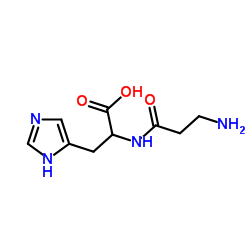Phospholipase D

Phospholipase D structure
|
Common Name | Phospholipase D | ||
|---|---|---|---|---|
| CAS Number | 9001-87-0 | Molecular Weight | 226.232 | |
| Density | 1.4±0.1 g/cm3 | Boiling Point | 656.2±55.0 °C at 760 mmHg | |
| Molecular Formula | C9H14N4O3 | Melting Point | N/A | |
| MSDS | Chinese USA | Flash Point | 350.7±31.5 °C | |
Use of Phospholipase DPhospholipase D (PLD) is an enzyme of the phospholipase superfamily, which widely exists in bacteria, yeast, plants, animals and viruses, and is often used in biochemical research. Phospholipase D can catalyze the hydrolysis of phosphodiester bonds in glycerophospholipids to produce phosphatidic acid and soluble choline. Phospholipase D is involved in a variety of disease-related processes, including diabetes, atherogenesis, obesity, tumorigenesis, immune response, and neuroendocrine function[1]. |
| Name | carnosine |
|---|---|
| Synonym | More Synonyms |
| Description | Phospholipase D (PLD) is an enzyme of the phospholipase superfamily, which widely exists in bacteria, yeast, plants, animals and viruses, and is often used in biochemical research. Phospholipase D can catalyze the hydrolysis of phosphodiester bonds in glycerophospholipids to produce phosphatidic acid and soluble choline. Phospholipase D is involved in a variety of disease-related processes, including diabetes, atherogenesis, obesity, tumorigenesis, immune response, and neuroendocrine function[1]. |
|---|---|
| Related Catalog | |
| References |
[1]. McDermott M, et al. Phospholipase D. Biochem Cell Biol. 2004 Feb;82(1):225-53. |
| Density | 1.4±0.1 g/cm3 |
|---|---|
| Boiling Point | 656.2±55.0 °C at 760 mmHg |
| Molecular Formula | C9H14N4O3 |
| Molecular Weight | 226.232 |
| Flash Point | 350.7±31.5 °C |
| Exact Mass | 226.106583 |
| LogP | -2.17 |
| Appearance of Characters | lyophilized powder |
| Vapour Pressure | 0.0±2.1 mmHg at 25°C |
| Index of Refraction | 1.591 |
| Storage condition | −20°C |
| Personal Protective Equipment | Eyeshields;Gloves;type N95 (US);type P1 (EN143) respirator filter |
|---|---|
| Safety Phrases | 7 |
| RIDADR | NONH for all modes of transport |
| WGK Germany | 3 |
|
Initial characterization of the human central proteome.
BMC Syst. Biol. 5 , 17, (2011) On the basis of large proteomics datasets measured from seven human cell lines we consider their intersection as an approximation of the human central proteome, which is the set of proteins ubiquitous... |
|
|
Global, in vivo, and site-specific phosphorylation dynamics in signaling networks.
Cell 127(3) , 635-648, (2006) Cell signaling mechanisms often transmit information via posttranslational protein modifications, most importantly reversible protein phosphorylation. Here we develop and apply a general mass spectrom... |
|
|
A quantitative atlas of mitotic phosphorylation.
Proc. Natl. Acad. Sci. U. S. A. 105(31) , 10762-7, (2008) The eukaryotic cell division cycle is characterized by a sequence of orderly and highly regulated events resulting in the duplication and separation of all cellular material into two newly formed daug... |
| 2-[(3-Aminopropanoyl)amino]-3-(1H-imidazol-4-yl)propanoic acid |
| Histidine, β-alanyl- |
| b-Alanylhistidine |
| β-Alanylhistidine |
| carnosine |
| N-(3-Aminopropanoyl)histidine |
| MFCD01457370 |
| MFCD00131791 |